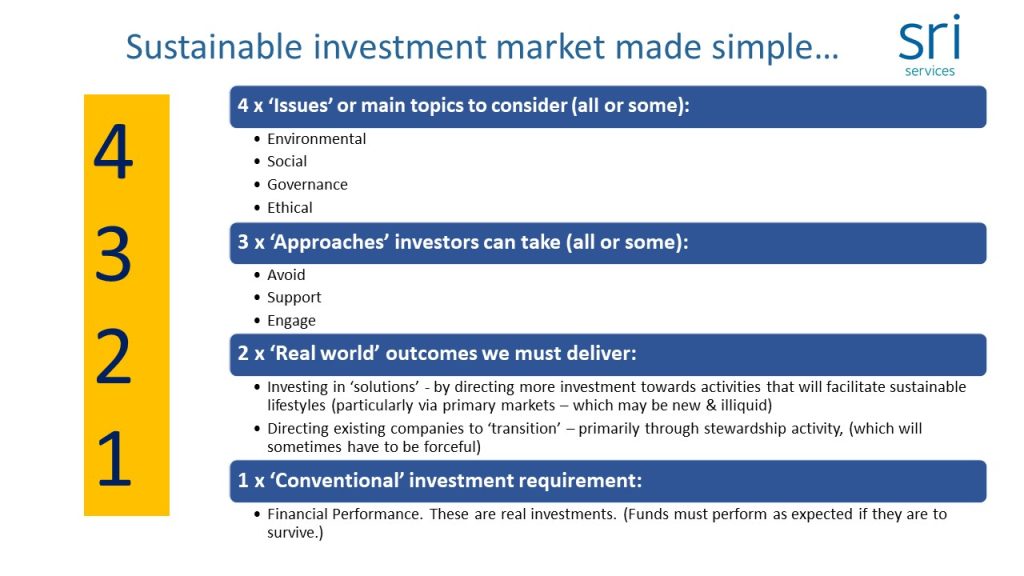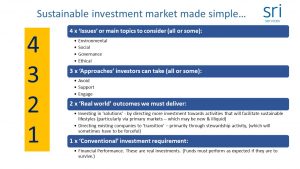Sustainable investment 4,3,2,1
Posted on: December 10th, 2021

As you are reading this post you may well know that I have spent nearly 30 years working in sustainable, responsible and ethical investment because I believe it can – and will – help deliver a better future.
I also believe it makes sound financial sense because there is no real alternative to shifting to sustainable lifestyles.
You might also know that I have mostly worked with retail intermediaries – in particular financial advisers – helping them to navigate sustainable investment. (I do so partly because I am a fan of the business model – and partly because they are the gatekeepers to significant amount of capital).
Although progress is being made – and I am delighted by the increased interest in sustainable investment – I am also increasingly frustrated at the way the area is made to look unnecessarily complicated.
Of course the sustainability challenges we face are interconnected and complex – but if we are to fulfil this area’s potential we need to ‘keep it simple’ – and use words people who are interested in sustainability understand. (In addition to being ultra transparent in support materials.)
The investment market thrives on complexity of course, but baffling intermediaries and clients with inexplicable data, metrics and methodologies is not, in my view, going to help deliver net zero, halt biodiversity loss, deliver equality or effect any of the ‘real world’ outcomes so many of us care about.* To do that we need clients to understand what funds do – and why.
It is with this in mind that I like to break sustainable investment into its constituent parts to help simplify conversations. One of my current favourites is using the ‘4, 3, 2, 1’ prompts below.
This is my attempt at the kind of ‘necessary simplification’ that I feel is crucial if we are to explain the complexities of this area beyond the ‘ESG bubble’ without baffling people.
This is not a ‘script’, but it will help intermediaries to explain what sustainable investment is about, why fund options are so diverse and generally help get the conversation started…
I hope you find this useful (please feel free to borrow if you wish – quoting source where appropriate)!
4 x Core ‘Issues’ or high level topics:
-
- Environmental
- Social
- Governance
- Ethical
3 x Core ‘approaches’ or investor responses
-
- Avoid
- Support
- Engage
2 x ‘Real world’ outcomes we must deliver:
-
- Investing in ‘solutions’ – by directing more investment towards activities that will facilitate sustainable lifestyles (particularly via primary markets – which may be new & illiquid)
- Directing existing companies to ‘transition’ – primarily through stewardship activity, (which will sometimes have to be forceful)
1 x ‘Conventional’ investment requirement:
-
- Financial Performance. These are real investments. Funds must perform as expected if they are to survive.
*I am making these points to illustrate that I am not jumping on the bandwagon or looking to dumb down the area for fun… indeed in some respects maybe I helped build the road 🙂
Example script:
“This area is complicated. Fund managers can choose to focus on any or all of the following four areas: environmental, social, governance ethical issues – many of which have dozens of sub categories.
There are however only three main ways fund managers can deal with any (or all) of these issues. – they can focus on choosing companies they believe are doing a good job, stay away from stuff (industries, business behaviours etc) that they don’t like or keep hold of a company and try to improve them (which we call responsible ownership or stewardship).
And there are two things we need to do as investors who care – ways in which investment interacts with the real world – we can (and must) drive more money into solutions that will help us make our lives sustainable (although this is a bit complicated in secondary markets like equities) and we need to help change what existing businesses do so that they become sustainable.
These can be combined in many different ways – hence the complexity of this market. But there is one thing all funds must have in common – they are all investments – so they need to make money. No fund can survive simply because it sounds nice!”
